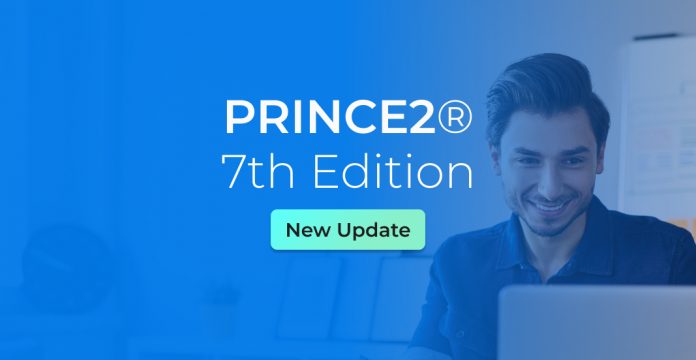
The PRINCE2® (Projects IN Controlled Environments) methodology has established itself as a highly dependable and esteemed framework for project management. The upcoming launch of its 7th edition in September 2023 is generating significant anticipation.
This eagerly awaited update is set to revolutionize the landscape of project management and execution. It will achieve this by integrating innovative concepts and aligning the methodology with prevailing trends in project management.
This article will extensively delve into the principal modifications introduced by the latest PRINCE2 7th edition. Furthermore, we will examine their ramifications on project management, their advantages to professionals and organizations, and strategies to prepare for this substantial evolution.
Table of contents:
- What is PRINCE2 7th Edition?
- Exploring the Latest Features of PRINCE2 7th Edition
- Reasons for the Updated Version of PRINCE2
- When is the Expected Release Date of PRINCE2 7th Edition?
- Which courses will have Impact of this Change?
- How does PRINCE2 7th edition affect you?
- Conclusion
What is PRINCE2 7th Edition?
PeopleCert/Axelos are introducing a new iteration of PRINCE2. This iteration, designated PRINCE2 7th Edition, is poised to supplant the existing 6th Edition.
What’s Changing in PRINCE2 7th Edition?
- Integration of Individuals: People have become the major aspect of project success, intricately integrated into the PRINCE2 approach
- Project Performance: To align with contemporary organizational requirements, a seventh dimension—sustainability—has been integrated into project performance evaluation
- Digital and Data: Recognizing the evolving demands of project management professionals, an innovative digital and data management approach has been incorporated
What has not changed in PRINCE2 7th Edition?
- The fundamental nature of a project remains unaltered—it remains temporary, product-oriented, and continually supported by ongoing business rationale
- The fundamental structure of PRINCE2 is immediately recognizable, with its guiding principles, practices (formerly known as themes), and a set of processes constituting the project lifecycle, akin to the previous version. However, nestled within and alongside these principles, practices, and processes, numerous modifications, additions, and omissions have taken place. This document is aimed at elucidating these changes.
- Diagrams have been refreshed, and four project scenarios have been introduced to demonstrate the practical application of PRINCE2 for varying project types
Exploring the Latest Changes of PRINCE2 7th Edition
Incorporating new content from MOR, this adaptation is carefully structured to align with PRINCE2 and project-level risk considerations. It avoids duplication of existing guidance while maintaining coherence with it.
The novel approach emphasizes practical application and tailored utilization of PRINCE2, addressing a common issue: the mechanical use of the methodology. Instances include the exhaustive utilization of management products and the execution of various actions and tasks with minimal deliberation.
The strategy for applying and customizing PRINCE2 has transformed. Instead of elaborating on the importance of tailoring, the focus shifts to demonstrate the practical implementation of the method.
Addressing the challenge of streamlining PRINCE2 learning, the update prioritizes essential content and minimizes distractions. Visual aids such as diagrams and illustrations are prominently integrated, enhancing focus and relevance throughout this revision.
Below is the comparison between PRINCE2 6th and PRINCE2 7th versions:
| Context | PRINCE2 6th Edition | PRINCE2 7th Edition |
| Integrated Elements |
|
|
| Project Management | Project management involves strategically planning, assigning tasks, overseeing progress, and maintaining command over every project facet. Additionally, it encompasses inspiring and motivating those engaged in the project, all aimed at attaining its objectives while aligning with predetermined benchmarks for time, cost, quality, scope, benefits, and risk. | Project management entails utilizing methods, tools, techniques, and proficiencies to achieve the project’s intended objectives. |
| Performance Targets |
|
|
| People | Not used | Used In:
The fundamental goal of a project is to bring about transformation, leading to impacts on individuals in their everyday business operations, routines, and duties. The effectiveness of change implementation and, consequently, the project’s overall performance hinge on the project team’s skills, the quality of their interactions, and the individuals affected by the change. |
| Change Management & Change Management Approach | Not used | Change management embodies how an organization progresses from its present condition to its desired future state. This change management approach is integrated into the project initiation documentation and defines the necessary transformational state the organization should reach to accomplish project objectives. It outlines the strategies by which the business will transition from its current state, traversing interim stages, to achieve the envisioned target state. |
| Multi-case Model | Not used | Assessing investments through diverse lenses, rather than solely prioritizing financial gains, offers a comprehensive assessment of an investment’s desirability, feasibility, and attainability. Some examples of alternative investment viewpoints encompass:
|
| Practices key relationship of principles | Not Used | Each practice chapter includes a section that delves into the specific connection between the practice and the underlying principles. |
| Risk management supporting techniques |
|
|
| Progress evaluation techniques |
|
|
Reasons for the Updated Version of PRINCE2
The transformation of the PRINCE2 methodology is influenced by several factors that acknowledge the changes since its last iteration.
Elements such as emerging technologies, environmental shifts, climate change concerns, evolving ethical values, changing consumer and corporate outlooks, updated governmental regulations at various levels, and novel working methodologies, including remote and hybrid practices, have all played a role.
Moreover, there’s a growing demand for individuals to cultivate soft skills, including leadership, which the newly introduced ‘people integrated element’ aims to address.
From an organizational perspective, the same driving forces mentioned above have shaped the methodology’s evolution.
However, this update will foster closer collaboration with multidisciplinary project teams and enhance communication channels, facilitate a deeper grasp of stakeholder requirements, and contribute to creating an organizational culture where change is embraced and executed more efficiently.
When is the Expected Release Date of PRINCE2 7th Edition?
Starting September 2023, individuals and organizations can opt for the PRINCE2 7the Edition training.
What Enhancements Have Been Made in the New Format?
The 7th edition introduces notable enhancements geared towards enhancing the adaptability and flexibility of the project management framework. Here are the primary areas of improvement:
1. Enhanced Flexibility: The rigid regulations have been streamlined in the chapters while retaining the fundamental elements of PRINCE2. This increased flexibility empowers project managers to customize the approach to suit their project’s distinct requirements while maintaining the core integrity of PRINCE2.
As a result, the methodology can be effectively employed across diverse projects, irrespective of their scale or domain.
2. PRINCE2 7th Edition for a Wider Audience: The latest edition of PRINCE2 has simplified the language and content in the official guidebook, making it more accessible to a broader range of individuals.
This initiative aims to make PRINCE2 understandable and applicable to a diverse group of professionals, whether they are newcomers to project management or seasoned experts. This also facilitates wider dissemination of this proven methodology.
3. Enhanced Adaptability for Greater Agility: The concept of customization is woven throughout the methodology, showcased through practical scenarios. This approach enables project managers to swiftly and flexibly respond to unforeseen changes or obstacles.
By giving project managers the authority to tailor PRINCE2 to specific contexts, they can adeptly navigate uncertainties and uphold project performance, regardless of evolving conditions.
By accentuating these improvements, the 7th edition of PRINCE2 equips project managers with potent tools to confront new challenges. These enhancements reinforce the status of PRINCE2 as a versatile and effective project management framework.
How does the latest PRINCE2 7th edition affect you?
The recent revisions to PRINCE2 have brought about a transformative shift in its real-world application. These adjustments concentrate on augmenting flexibility, accentuating collaboration and human interactions.
They also give prominence to project performance and the realization of benefits while integrating best practices and accounting for the project’s unique context.
What Advantages Does the New Edition Offer to Project Managers and Organizations?
The new edition offers project managers the advantage of skill enhancement and customized approaches. It also fosters heightened engagement with stakeholders and ensures diligent performance tracking.
For organizations, the benefits encompass uniform practices, elevated success rates, optimized resource allocation, and an enhanced reputation. These cumulative effects lead to prosperous project delivery and organizational advancement.
Conclusion
Brace yourself for captivating and innovative project management training. Dive into the dynamic realm of PRINCE2 (7th edition) now and nurture your project management capabilities.
Prepare to venture into fresh, professional landscapes and embrace the opportunity presented by the new certification. Be among the pioneers to harness the potential of PRINCE2 version 7 Certification.
Top FAQs on New PRINCE2 7th Edition
1. Which courses will be affected by the change of the version?
The following courses will be impacted:
- PRINCE2 Foundation Certification
- PRINCE2 Practitioner Certification
- PRINCE2 Foundation and Practitioner Certification
2. I acquired the PRINCE2 6th edition Foundation certification.
Suppose you have a Foundation qualification in PRINCE2 6th Edition. In that case, while you are eligible to pursue the 7th Edition of Practitioner directly, it’s advisable to consider progressing further within version 6 due to the alterations in terminologies.
3. Can I re-register for PRINCE2 7th edition while having PRINCE2 6th edition qualification?
If you intend to register for the 7th Edition, it’s advisable to commence from the 7th edition Foundation level. Alternatively, you can enroll in the 6th Edition Practitioner-only course.
4. What modifications will occur in the PRINCE2 exams?
- Foundation Level: The structure of the PRINCE2 Foundation level examination remains unaltered for the 7th Edition. However, the passing score has been elevated from 55% to 60% (requiring 36 correct answers).
- Practitioner Level: The PRINCE2 7th edition Practitioner exam will encompass 70 questions, compared to the previous 68. The new passing score is 60%, unlike the previous 55%. The duration of the exam remains unchanged at 2.5 hours.The Practitioner exam will be centered around one of the four scenarios featured in the new version of the manual.
5. When can I enroll for the updated PRINCE2 7th edition course?
Invensis Learning will schedule courses for the 7th Edition starting September 2023.
6. What are the prerequisites for the latest PRINCE2 7th edition certification?
Foundation Level: None
Practitioner Level:
- PRINCE2® 6th Edition (Foundation or Practitioner)*
- PRINCE2® 7 Foundation
- Project Management Qualification (PMQ)
- Project Professional Qualification (PPQ)
- Project Management Professional (PMP)®
- Certified Associate in Project Management (CAPM)
- IPMA Level A® (Certified Projects Director)
- IPMA Level B® (Certified Senior Project Manager)
- IPMA Level C® (Certified Project Manager)
- IPMA Level D® (Certified Project Management Associate)













